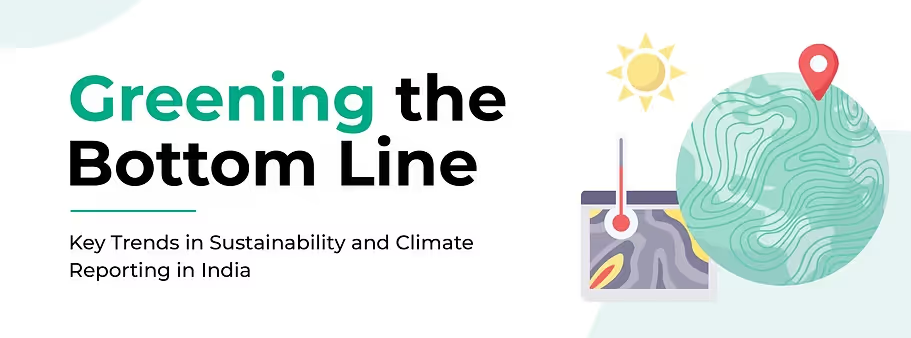
Solutions
Carbon Management
ESG Intelligence
Climate & Nature Risk
Data Registry
Beta
Sector
Get started, schedule a demo or request a free assessment!


The winds of change are swirling through India's corporate landscape. No longer is financial performance the sole yardstick of success. Today, companies are judged by their commitment to a broader vision – one that weaves environmental responsibility, social consciousness, and ethical governance into the very fabric of their operations. This paradigm shift is driving a surge in sustainability and climate reporting, painting a compelling narrative of India's journey towards a greener future.
The Business Responsibility and Sustainability Reporting (BRSR) framework, implemented by SEBI, stands as a pivotal moment. This mandatory regulation for the top 1000 listed companies demands transparency on nine key ESG pillars, aligning India with global best practices while acknowledging its unique context. It's akin to laying the foundation for a responsible future, ensuring companies actively consider the environmental and social impact of their actions.
Charting the Course: But BRSR is just the first step. To ensure their reports resonate with stakeholders and address their most pressing concerns, companies are increasingly focused on materiality assessments. Imagine this as a compass, meticulously identifying the most significant social, environmental, and economic impacts of their operations. This empowers them to tailor their reporting strategy, focusing on the issues that truly matter, and fostering a dialogue built on mutual understanding.
Technology is no longer a bystander in this evolving narrative. It's emerged as a powerful catalyst, transforming the way ESG reporting is conducted. Digital solutions are streamlining the process, from data collection and analysis to report generation. This translates to greater efficiency, accuracy, and transparency. Imagine mountains of data transformed into clear, concise visuals, allowing companies to generate investment-grade ESG information that stakeholders can easily comprehend.
To further bolster the credibility of their sustainability claims, companies are increasingly seeking external assurance from independent third parties. This acts as an impartial auditor, verifying the accuracy and completeness of their ESG disclosures. Think of it as a stamp of approval, adding a layer of trust and ensuring stakeholders can make informed decisions based on reliable information.
While BRSR serves as a regulatory nudge, a growing number of companies are recognizing its true potential. They're viewing it not just as a compliance exercise but as an opportunity to showcase their commitment to responsible practices. This shift in perspective is reflected in the rising number of companies – with over 75% now reporting on sustainability – demonstrating their dedication to environmental stewardship and attracting environmentally conscious investors.
India, with its diverse geography and population, is particularly vulnerable to the impacts of climate change. Recognizing this reality, companies are incorporating climate resilience strategies into their reports. This is akin to building a shield, outlining their preparedness for future challenges like extreme weather events and water scarcity. It demonstrates a proactive approach, showcasing their commitment to building a sustainable future not just for themselves, but for generations to come.
The Reserve Bank of India (RBI) introduced draft guidelines requiring banks and other financial institutions to disclose how they identify and manage climate-related risks and opportunities. This applies to a broad range of institutions including banks, credit unions, and non-banking financial companies.
These guidelines aren't surprising. The RBI has been taking steps towards addressing climate risk for a while, including joining an international group on greening the financial system and releasing related reports.
The disclosures will focus on four key areas: how the bank is governed regarding climate risk, its strategy for dealing with it, how it manages the risks, and what metrics and targets it has set. This aligns with international standards set by the Task Force on Climate-related Financial Disclosures (TCFD).
Banks will need to report on not just their progress in meeting targets but also how they're managing these risks. This includes board oversight, senior management involvement, and how they've identified climate risks that could impact their business in the short, medium, and long term.
It's important to note that, unlike recent regulations in the U.S., these guidelines require reporting on all three scopes of greenhouse gas emissions (Scopes 1, 2, and 3). This aligns with international best practices set by the NGFS and other jurisdictions in Asia and Europe.
These trends paint a promising picture of India's dedication to building a sustainable future. As regulations evolve and stakeholder expectations continue to rise, we can expect further advancements in areas like:
India's journey towards responsible corporate practices is far from over. It's a continuous voyage, fueled by collective action and a shared vision for a sustainable future. By embracing these trends, companies can not only ensure compliance but also carve a path towards a future that is environmentally responsible, socially conscious, and economically prosperous, leaving a legacy that transcends generations.

.svg)